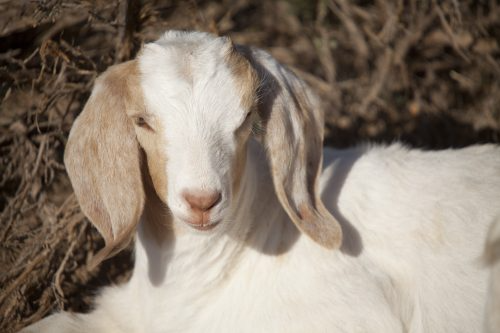BOER, SPANISH, MYOTONIC OR KIKO

Why Kiko Goats?
How does the Kiko Goat compare to the other popular meat goat breeds?
Common Meat Goat Breeds in the U.S.
-
Boer Goats
The Boer goat is the most popular meat goat breed in the United States. Developed in the arid regions of South Africa, they were first introduced into the U.S. in 1993. Boer goats are easily distinguished buy their white bodies and red heads, although other color varieties do exist. The breed is known to be docile, have high fertility and a fast growth rate.
-
Kiko Goats
The Kiko goat was first inported into the United States from New Zealand in the mid-1990s. The breed was developed by the systematic breeding of feral does with dairy bucks with further crossbreeding and interbreeding at the F2 and F3 generations. The breed was developed from the F4 generation. They are most known for their parasite resistance, fast growth rate, and ability to thrive under limited producer input.
-
Spanish Goats
The Kiko goat was first inported into the United States from New Zealand in the mid-1990s. The breed was developed by the systematic breeding of feral does with dairy bucks with further crossbreeding and interbreeding at the F2 and F3 generations. The breed was developed from the F4 generation. They are most known for their parasite resistance, fast growth rate, and ability to thrive under limited producer input.
-
Myotonic Goats
Also referred to as the fainting goat, the myotonic was developed in Tennessee. They are best known for their muscle condition called myotonia congenita, which makes them appear to "faint" when stressed although they actually remain conscious. They are bred for meat and as pets, so breed characteristics vary more than other meat breeds. They are typically smaller in size compared to Boers and Kikos, but are heavily muscled for their size. Little research has been conducted comparing Myotonic goats to the other meat breeds, but that will hopefully change in the future.
Available Research
Multiple short-term and long-term research studies have been conducted at Tennessee State University by Dr. Richard Browning, Jr. and associates comparing the traits of the Kiko, Spanish and Boer goat breeds in a production environment. I will focus on the long-term study conducted, but you can listen to Dr. Richard Browning, Jr.’s overall opinion of the breeds by selecting the podcast link to the left.
Boer, Kiko and Spanish Goats
HOW THEY STACK UP
A long-term (six year) study was conducted by R. Browning Jr., M. L. Leite-Browning, and M. Byars Jr. assessing the fitness of each goat breed on pastures in the southeastern United States managed together in a semi-intensive manner. A 3-breed diallel mating scheme was used with Boer, Kiko, and Spanish bucks with kidding in March or May. The traits assessed and their findings are listed in the table below. The overall conclusion of the study was “Boer does expressed substantially decreased levels of fitness compared with Kiko and Spanish does when semi-intensively managed on humid, subtropical pasture. Kiko and Spanish should be preferred as maternal breeds in meat goat production systems under conditions reflective of this study.”

R. Browning Jr., M.L. Leite-Browning, and M. Byars Jr. Reproductive and health traits among Boer, Kiko, and Spanish meat goat does under humid, subtropical pasture conditions of the southeastern United States. J. Anim. Sci. 2011. 89:648-660.